Italian Customs, Food And More...
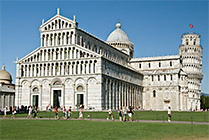 In addition to general information about Italy from the previous page, we present here more details on the following topics:
In addition to general information about Italy from the previous page, we present here more details on the following topics:
- customs,
- wine,
- food,
- restaurants.
Italian Customs
Italians Like Children
We noted several times the fact that the Italians are very fond of children. With kindness and a smile they approach toddlers. In places where we rented apartments, the owners let our little son to do a lot. He was allowed to gather fresh fruits in the gardens.
Although we knew the Italian fondness for children, once we were very surprised. We walked to a monastery of Monte Oliveto Maggiore and our son ran ahead down the street to the entrance. For a moment he disappeared from the sight, and after a while came limping in the company of two men supporting him on the sides – from forehead, a blood flowed down his face...
We did not know what has happened. I immediately have seen through the eyes of imagination a fast drive to a hospital, stitching wounds, etc. We did not have at hand any bandages, and auto was staying in the parking lot away from this place.
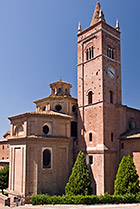 We even didn't have time to react, and one of the Italians already took care of him. Standing next to his car he pulled compress and hydrogen peroxide, cleaned the wound and from a special first aid kit pulled out a bag of ice. Yes! In this heat a bag of ice! He slammed his fist into the bag, crushed the ice and put such compress to our son's face.
We even didn't have time to react, and one of the Italians already took care of him. Standing next to his car he pulled compress and hydrogen peroxide, cleaned the wound and from a special first aid kit pulled out a bag of ice. Yes! In this heat a bag of ice! He slammed his fist into the bag, crushed the ice and put such compress to our son's face.
It turned out that those Italians were the team renovating the historic buildings of the abbey. The head of the team had there the car with the equipment and the great first aid kit. He was really well prepared for any circumstances. He was very worried and asked if the son has vertigo, nausea, and whether immediately call a doctor.
Several people from the team gathered around us. They were genuinely interested, they asked how he feels, whether call a doctor. Everyone feared concussion. Then again this gentleman came up to us and using sticking plaster glued compress to our son's forehead.
Initially, it seemed that our son tripped over the uneven part of the road and fell to the ground, hit his head on the pavement, cutting the forehead. Only then we came to the conclusion that probably it was a different story... He had shifted sunglasses on his head, and when he hit the pavement, glasses protected forehead, but one of their nose pads pierced the skin. Our son felt more the pain in not wounded knees than in his face...
This interest in children, caring, and selfless desire to help are amazing.
The Italian Way To Save From Fainting
Once, after a few hours of exploring the city in the heat of the day, without frequent drinking water, my wife took a seat in a restaurant, already feeling bad. She was weak.
Owner of the restaurant serving us noticed this and proposed drinking water with sugar. She immediately brought an extra glass, more still mineral water and sugar. It worked! After a while my wife felt better. Please note - in hot weather drink plenty of water.
Breaks During The Day
A break during the day is quite common in some countries especially in South Europe. Be prepared for problems with shopping between 12:30 and 16:00 in the small towns. Large shopping centers usually operate without breaks. Also, the restaurants are closed in the afternoon. They are open around 12:00-15:00 and then again since 19:00 till the night. This is related to the Italians' rhythm of life. In some big cities and areas popular among tourists restaurants are open in the afternoon as well.
Museums usually are open over the weekend, but then quite often are closed on Mondays.
Visiting Churches
Visiting the churches in Italy in short trousers, a short skirt and a sleeveless shirt is unwelcome. In some temples at the entrance you can get a cloth to cover bare arms. When you plan to visit religious sites, wear something with short sleeves, even a t-shirt and take care of trousers or skirts below the knee.
When visiting churches, plan for the time when the Holy Mass is not celebrated. In many temples, walking and watching the interior at the time of the Mass is prohibited.
Cappuccino
In Italian the coffee is caffè. Cappuccino is an Italian coffee drink which is quite popular outside of the country and is drunk almost the whole day, whereas in Italy it's not. Italians drink cappuccino in the morning, till the noon, and espresso all day long. Other drink, caffè latte, Italians are preparing in the morning for breakfast, pouring a coffee to the warm milk in a cup and often this coffee is moka.
Moka
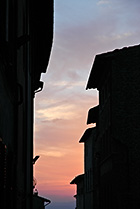 Moka is a separate story - is very popular in Italy. Special moka pots (mainly made by Bialetti - named after the company founder) usually can be found in the holiday apartment.
Moka is a separate story - is very popular in Italy. Special moka pots (mainly made by Bialetti - named after the company founder) usually can be found in the holiday apartment.
And here is the short story, how we have shown ignorance about the local customs. During our first holidays in Tuscany I was not able to find a coffeemaker (the "normal", drip brewing) in the apartment, and I knew it should be there according to the description of the offer. As we are coffee drinkers, the next morning I went to the owner asking why the coffeemaker is missing. He was terribly surprised and embarrassed - clearly he was sure that everything is fine and it should be there. He invited me to his kitchen and pulled out from the cabinet his coffeemaker, hmm... he said so. This was a bizarre coffee pot, and seeing my probably awfully silly face, he has explained how to use it.
I went back to the apartment and in the kitchen cabinet, of course, I found this odd coffee pot... So, I went back to our host giving him his pot, admitting that we did not know what it was and how to use it.
Travelling several times to Italy, we got used to Italian coffee and finally we bought our own moka pot.
It is worth to look at Wikipedia page about moka pot, as it shows the pot, explains how it works and how to make a moka.
Suggestion – it's better to wash the moka pot by hand, not in the dishwasher.
Important note – the coffee served in many European countries (including Italy) is much stronger than the coffee people used to drink in US. So in many hotel bars the foreigners are asked whether they prefer American coffee instead. Keep that in mind ordering your drink.
Coperto And Tipping In Italy
The issue of coperto and tip is quite complicated. The custom suggests giving a tip, but...
Coperto - if you find this item on the bill, this is normal, it's the cover charge (table charge). It's kind of entrance fee and usually it's not high. It is sometimes regarded as "service", often it includes served bread, olive oil etc. not charged separately. A separate cover charge may make sense.
Italians going to the restaurant with their family, not always order the entire dinner for everyone. For a child, for example, they ask only for a plate and from the other plates they gather a bit of food for the kid. This is rational.
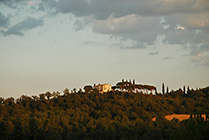 Once in Tuscany, in Val d'Orcia we ordered for our 5 years old child a salad, because the waiter said that they could provide smaller size. He then brought a huge plate with great salad and fried egg on top. When he put a plate in front of a little guy, people around started to smile. Indeed, the scene was quite funny. The result was obvious, the child just made a small cut into this mountain of food and since then we have asked often only for an extra plate...
Once in Tuscany, in Val d'Orcia we ordered for our 5 years old child a salad, because the waiter said that they could provide smaller size. He then brought a huge plate with great salad and fried egg on top. When he put a plate in front of a little guy, people around started to smile. Indeed, the scene was quite funny. The result was obvious, the child just made a small cut into this mountain of food and since then we have asked often only for an extra plate...
Tipping - in some restaurants the bill includes a service, or "servizio" in Italian. Sometimes it is 10%, and sometimes 15%. Some restaurateurs provide this information in the menu. Generally, if you do not see the service fee, or if they clearly write "no servizio", and the amount of the bill does not imply high cover charge, then give a tip.
In Italy, clients usually leave the tip around 10%, sometimes just small change, rounding the bill. Americans are often more generous customers than the others. I believe, however, that as clients we can expect that the waiter shows that he/she cares... It happened that when we had to wait for a very long time and the waiter was arrogant, there was no tip.
Bills And Taxes
During our recent stay in Italy a saleswoman in a wine shop surprised us. After selling a wine she gave us a receipt from the cash register. Traditionally I waved my hand - I don't need it. Lady kindly explained that in Italy the client after leaving the restaurant or shop may be in trouble, if he does not have the proof of payment and the Guardia di Finanza (Finance Guard) would control him. They simply assume that the goods or services were received as a gift. It's better to take the receipt and keep a peace of mind.
Probably this is the way the Italians avoid taxes - giving away gifts. The system must be very ill, since the government is not normally able to collect taxes and instead of pursuing those who they should - entrepreneurs, so shopkeepers or restaurateurs, they chase the unfortunate customers. It's easier to catch a poor guy with shopping bags and without the receipt in a pocket than a reseller in the act of not using the cash register. Quite absurd. We have not faced such control, but who knows... Perhaps the Italian government must now try harder to improve the situation of state finances...
Italian Wines
Italians drink wine with a meal, lots of wine. They also have a huge selection of this divine drink. By the way, note - if you see the road sign Cantina, do not count on the food, the wine is produced there...
Here are a few (interesting) examples of wines from the described regions.
- Chianti
Chianti is one of the most famous Italian red wines. It's named after the Chianti region in central Tuscany, where it was produced. Characteristic for Chianti was a bulgy, slightly pear-shaped bottle in a straw basket. Currently, most of the wines are bottled in standard bottles.
The official history of the wine dates back to 1716, when, for the first time, the area of production was defined. Two hundred years later, in 1932 the Chianti area was widely extended. In order to control the quality of the wines, in 1967 an appellation was introduced, now DOCG (Denominazione di Origine Controllata e Garantita). For the production of Chianti initially only Sangiovese grapes were used. In the nineteenth century, Baron Bettino Ricasoli, the largest producer of wine (and a deserved figure for Italy and its independence) introduced modifications in the form of 70% Sangiovese, 15% Canaiolo and 15% white Malvasia. However, since the 1970's, manufacturers return up to 100% Sangiovese.
On the necks of some bottles you will find a badge with black rooster (Gallo Nero), a sign of an association of producers of Chianti Classico. It is the wine from the sub-area which was the initial heartland of Chianti. - Vino Nobile di Montepulciano
It is a good red wine produced in the area of Montepulciano. They are mainly prepared from Sangiovese (minimum 70%), Canaiolo red grapes (10% -20%), and minor additions of other local varieties. Production is a subject of DOCG appellation. Some argue that the Vino Nobile di Montepulciano is nobler than Chianti...
Do not confuse this wine with Montepulciano d'Abruzzo, which is produced from Montepulciano grapes in the region of Abruzzo. - Brunello di Montalcino
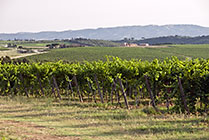 It is an Italian red wine produced in the vineyards surrounding, of course, Montalcino. It is one of the most prominent and often most expensive Italian wines... The first mention of Brunello comes from the fourteenth century. It's produced from Brunello grapes, a Sangiovese variety growing in the region of Montalcino. Production is a subject of DOCG appellation granted in 1980.
It is an Italian red wine produced in the vineyards surrounding, of course, Montalcino. It is one of the most prominent and often most expensive Italian wines... The first mention of Brunello comes from the fourteenth century. It's produced from Brunello grapes, a Sangiovese variety growing in the region of Montalcino. Production is a subject of DOCG appellation granted in 1980. - Amarone (Amarone della Valpolicella)
It is a dry red wine made from partially dried grapes of the Corvina (40% - 70%), Rondinella (20% - 40%) and Molinara (5% - 25 %). In 1990 the wine was given DOC status (Denominazione di Origine Controllata) and in 2009 DOCG. For comparison, Amarone has a shorter history. The first mention comes from 1938 and officially it's available on the market from the 1953. Production of this wine is relatively small. It occupies only 10% of the winemaking area of province of Verona, called Valpolicella.
The production process distinguishes Amarone from the other wines. At the beginning, after harvesting selected grapes are dried on average about 120 days. This part of the process allows for further concentrating the juice, that is, sugar and flavors. This is followed by fermentation and maturation. The Amarone matures for a long time, usually 5 years. Complicated process increases the risk of quality problems, hence affects the amount of wine on the market and its price, which is rather high. As a result the wine is ripe, full, with a small amount of acid. The wine is slightly stronger, contains 15% alcohol (minimum 14%). - Vernaccia di San Gimignano
In Tuscany, the local wine specialty is Vernaccia di San Gimignano, a dry white wine made from grapes Vernaccia. The tradition of Vernaccia winemaking dates back to the thirteenth century. Since ancient times, it is considered one of the best Italian white wines. I read that Vernaccia wines are also produced in Sardinia and the Marche region, but this is apparently not the same grape variety and the Vernaccia grapes planted in San Gimignano surroundings are the oldest. Production of Vernaccia di San Gimignano, which is a subject of DOCG appellation, is concentrated in the vicinity of the medieval city (area Comune di San Gimignano). Personally we have especially enjoyed the Vernaccia produced by Pietrafitta. - Vin Santo
Vin Santo is a dessert wine, usually sweet, and amber in color. The most likely origin of the name stems from the frequent use of it as a sacramental wine. It is made using more difficult technology, from pre-dried grapes, which gives more concentrated juice. The high sugar content affects the higher alcohol content. Traditionally, the wine matures in oak barrels from the previous production of Vin Santo, and the remaining sludge from the prior wine maturation plays an important role in the whole process. This wine is quite common in Tuscany and Umbria. In the past many Italians living in the countryside were producing their own Vin Santo, jealously guarding their recipes.
Wine can often be purchased locally, directly from the manufacturer. This way good wine can be bought cheaper.
Once, we were spending holidays in Tuscany, renting apartment in the region of Brunello. Supervisor of the apartments had in his, hmm..., let's call it office, a wine produced by the owners of the property (and surrounding vineyards). He had on sale the bottles of Brunello, but the price of which was the standard high, so not too interesting for us to buy.
Before leaving, out of curiosity, I checked at the store in nearby Montalcino that the Brunello brand produced by owners of our apartments was one of those "better" ones. So I was trying to talk to the supervisor about the wine. Unfortunately, he spoke only Italian, so we had a problem with understanding each other. But from his words and gestures I grasped that the Brunello is controlled, production limited, it must be packaged properly, etc. So that's why the cost is high... "But I have also this wine" – he said, showing a 3-liter big bottle of red wine with the label Vino Rosso da Tavola.
As for the table wine, it was not the cheapest. As for the wine made there, in the famous region, using proven technology... I understood the hint and bought 2 bottles. We have tried it after returning home. The wine was excellent! I knocked my head - we were going to the shops to buy more expensive wine not necessarily better, instead of buying throughout our stay this "table wine".
Conclusion - first check the local bargains, starting the testing from the low-cost table wines...
Italian Food
The costs of food were discussed in the section "Currency and costs" on the previous page, where we presented general information about Italy.
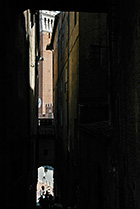 Tuscan bread (pane toscano) very popular in this region, also in Umbria is unsalted, so at the beginning it could be a problem. Tuscan bread is quite interesting. It has a hard crust, when it stales it's not getting moldy, soaked doesn't break apart – it's ideal for Panzanella, the bread salad. It's worth to try. Panzanella (also called panmolle) is characteristic for the central Italy, it's a great example of how to utilize unused food - stale bread.
Tuscan bread (pane toscano) very popular in this region, also in Umbria is unsalted, so at the beginning it could be a problem. Tuscan bread is quite interesting. It has a hard crust, when it stales it's not getting moldy, soaked doesn't break apart – it's ideal for Panzanella, the bread salad. It's worth to try. Panzanella (also called panmolle) is characteristic for the central Italy, it's a great example of how to utilize unused food - stale bread.
The bread is unsalted, because according to a legend, at the time of city-states and continuous mutual fights, Pisa having access to the sea salt has imposed high taxes on salt, so people preferred to eat bread without it. The truth is probably a bit different. The unsalted bread fits in well for a variety of Tuscan dishes rich in flavor.
What to do if you want to eat a sandwich? In the stores you have to ask for salted bread - "pane salato", because it's of course also available. Regarding the bread rolls there's no problem, they are salted, as you would expect, and generally they are very good.
Speaking of bread, in Tuscany you will find in a menu items called crostini and bruschetta.
Crostini is a small snack, made from toasted or grilled unsalted bread, or slices of ciabatta. They are topped with olive oil and pastes made from tomatoes, olives, truffles, foie gras, etc.
Bruschetta [pron.: bruˈsketta] (in Tuscany also called fettunta) is usually slightly larger piece of grilled bread brushed with olive oil and rubbed with garlic, with salt and pepper, usually topped with chopped tomatoes and onions, sometimes with ham, vegetables etc. It's a great snack.
Focaccia [pron.: foˈkattʃa] – nearly everybody knows the Italian pizza, but I think very few people ate focaccia. This is type of bread that often resembles pizza, but it has thick dough. In general, focaccia is flat bread made from salted yeast dough with olive oil and herbs on top, and often olives, onions, cheese, meat or vegetables. Focaccia alla Genovese is a version with surface smeared with olive oil and sprinkled with salt. Focaccia is sometimes served for breakfast or at the beginning of the meal, to make it easier to wait for the main course, or is used as the basis for sandwiches. There is also a sweet version (focaccia veneta) with sugar, eggs and raisins, it's a bit like yeast cake.
Cantuccini are small almond cookies, popular in Tuscany. They are also called cantucci, or biscotti di Prato, so in English "biscuits from Prato" - the city in northern Tuscany, where it originated. Cantuccini are oblong-shaped, and formed by cutting diagonally at an angle the elongated dough piece. They are baked twice, so they are quite dry and hard. The best way to eat cantucci is to dunk them in a coffee or in another Tuscan specialty - Vin Santo.
Cheese – there are quite a lot of interesting types of cheese in Italy. The one we really like is pecorino, the sheep cheese. You can buy it especially in Pienza. You must try it – it's great, and how many varieties! Pecorino Romano (brand protected in the European Union) is a frequent addition to pasta, as – probably more recognizable – Parmesan cheese (Parmigiano Reggiano).
Dry cured ham is worth tasting. The well known are from areas of Parma - Parma ham (Italian Prosciutto di Parma) and San Daniele. It's called prosciutto crudo, and it's served uncooked, cut in very thin slices. The best ham is fresh, just cut in slices, you can eat it alone or for example served with melon (Prosciutto e melone)...
Bistecca alla Fiorentina - Florentine steak it's a Tuscan specialty, thick and huge beef steak from cattle reared in the Chiana Valley (Italian Val di Chiana), hence the name Chianina. It's the oldest and largest in the world breed of domestic cattle. Another source of meat is slightly less famous breed Maremmana from Maremma (in south-western Tuscany). Classic Florentine steak is roasted on the grill for a relatively short time 3-5 min. per side, so it's rather rare. If it's part of a larger meal, one steak can be shared by 2 persons.
Once in Radda in Chianti we ate a good dinner with bistecca alla fiorentina as the main course. It is a thick piece of meat, so we asked for a well-done, because we were afraid that in the other case the blood will be pouring out of it. Waiter pleadingly said "please, just not well-done, let it be medium rare". The steak was cut into pieces which were grilled separately, and then it was served on a big plate. The meat was very soft. After putting the dish on the table, the waiter suggested that they usually pour olive oil over the meat. We did it - it was delicious...
Trippa is the Italian tripe. We ate Trippa in Florence. It was served on a flat plate, and had vegetable taste, with strong influence of tomatoes. Tomatoes and parmesan imprint strong Italian mark on the tripe. There are local versions of tripe available, like Trippa alla Fiorentina in Florence and Trippa alla Romana in Rome.
Ribollita is popular mostly in the region of Florence and Arezzo. It's called "bread soup", but the food can be quite dense. It is done mainly with cabbage and beans, with the addition of stale bread. It may also contain onions, carrots, kale, or chard, and of course a little olive oil. Bread must be decent - from Tuscany. As you see, ribollita is a vegetable soup with stale bread. Allegedly the longer it is cooked, the better.
Fruits and vegetables - fresh, naturally matured under Tuscan sun, tastier than could be bought in many other countries, so worth to try.
And the olive oil as an addition to nearly everything. This is one of the basic elements of Italian cuisine. If you are not already a fan of Mediterranean cuisine, you'll become one.
Italian dinner - usually the main meal of the day consists of 3-4 dishes:
- Aperitivo - aperitif to stimulate the appetite, such as Campari, Cinzano, and Vermouth
- Antipasto - exactly "before the meal", cold or hot snacks
- Primo - "first course", usually warm pasta, risotto, polenta or soup
- Secondo - "second course", main dish, usually fish or meat
- Contorno - "side dish", served in addition to the main dish on a separate plate, e.g. salad, cooked vegetables
- Formaggio e frutta - "cheese and fruits", the first dessert; cheese can also appear as an Antipasto or Contorno
- Dolce - "sweet", dessert, like cakes etc.
- Caffè - coffee
- Digestivo - "for digestion", liquors such as grappa, amaro, limoncello, sambuca
Italian Restaurants
You can find in Italy several types of restaurants - ristorante, trattoria, pizzeria, osteria, taverna:
- pizzeria – it is the effect of commercialism, a restaurant serving mainly pizza
- trattoria - usually (at least in the past) it was a less formal place than a ristorante; lower prices provide a greater flow of customers; wine is easier to buy in parts of liter than in bottles, and maybe the food is not very refined, but often very good and has local roots
- taverna - it's an Italian pub
- osteria - inn, where they drink wine, and also eat some snacks
- ristorante – the "real" restaurant, so expect "higher level" of service than in the other places, with tablecloth on the tables, nicer interior and higher prices...
The differences among them slowly fade and all of them can be treated as restaurants, but you should keep in mind that the places without a "Ristorante" in the name may be cheaper.
Generally we do not recommend restaurants on this website. We do it on purpose, because we do not have a chance to test all of them, and do not want to be unfair omitting some nifty. Prices may vary, and you can easily check them and compare, because the menu is often shown at the entrance.
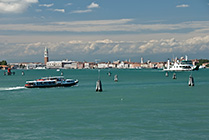 The appearance of the restaurant does not indicate the quality of food. Often modest-looking local eatery serves fantastic food, at the same time inexpensive.
The appearance of the restaurant does not indicate the quality of food. Often modest-looking local eatery serves fantastic food, at the same time inexpensive.
It is important that in Italy it is difficult to find the awful food. It's easier to face the poor service, especially in very popular tourist destination (such as Venice and its sometimes arrogant waiters).
In the US, clients are accustomed to good and quick service. Traveling to Europe, they should be prepared to wait a bit longer for the waiter, for food, for the bill.
Some time ago in one restaurant, in addition to coperto and servizio they counted the wrong price and had overcharged the bill. We noticed this, because all the prices of main courses were the same, while we ordered a variety of dishes. Of course, the prices were "the higher ones". After asking the owner for the explanation, she agreed that we are right. She has corrected the prices, but did not apologize... They have disappointed us, as we were eating in this place already several times. It's worth to be cautious.
To wrap up – it's a good idea to visit the local restaurants. In small towns they are sometimes quite picturesque. In large cities, you can find places especially crowded with local people. It's immediately obvious that these are good places. Once, we came across a restaurant in Arezzo, a little on the side of the main street. It was lunchtime, plenty of people inside, many in suits, also uniformed police or carabinieri. The service was fast, the food was good, and the prices were reasonable.